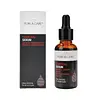What's inside
What's inside
 Key Ingredients
Key Ingredients

 Benefits
Benefits

 Concerns
Concerns

No concerns
 Ingredients Side-by-side
Ingredients Side-by-side

Water
Skin ConditioningPropanediol
SolventDipropylene Glycol
HumectantCorn Gluten Amino Acids
Skin ConditioningGlycerin
HumectantGlyceryl Glucoside
HumectantSaccharide Isomerate
HumectantCharcoal Powder
AbrasiveSodium Hyaluronate
HumectantMelaleuca Alternifolia Leaf Oil
AntioxidantScutellaria Baicalensis Root Extract
AstringentHouttuynia Cordata Extract
Skin ConditioningPortulaca Oleracea Extract
Skin ConditioningOpuntia Ficus-Indica Extract
Skin ConditioningPaeonia Suffruticosa Root Extract
Skin ProtectingChrysanthemum Indicum Flower Extract
Skin ConditioningAllantoin
Skin ConditioningPanthenol
Skin ConditioningTocopheryl Acetate
AntioxidantLactic Acid
BufferingArginine
MaskingCitric Acid
BufferingSodium Citrate
Buffering1,2-Hexanediol
Skin ConditioningHexylene Glycol
EmulsifyingXanthan Gum
EmulsifyingHydroxyacetophenone
AntioxidantSodium Hydroxide
BufferingLimonene
PerfumingWater, Propanediol, Dipropylene Glycol, Corn Gluten Amino Acids, Glycerin, Glyceryl Glucoside, Saccharide Isomerate, Charcoal Powder, Sodium Hyaluronate, Melaleuca Alternifolia Leaf Oil, Scutellaria Baicalensis Root Extract, Houttuynia Cordata Extract, Portulaca Oleracea Extract, Opuntia Ficus-Indica Extract, Paeonia Suffruticosa Root Extract, Chrysanthemum Indicum Flower Extract, Allantoin, Panthenol, Tocopheryl Acetate, Lactic Acid, Arginine, Citric Acid, Sodium Citrate, 1,2-Hexanediol, Hexylene Glycol, Xanthan Gum, Hydroxyacetophenone, Sodium Hydroxide, Limonene
Water
Skin ConditioningButylene Glycol
HumectantHydrolyzed Collagen
EmollientCorn Gluten Amino Acids
Skin ConditioningDipropylene Glycol
HumectantPhenoxyethanol
PreservativeSodium Hyaluronate
HumectantMorus Alba Root Extract
BleachingSodium Polyacrylate
AbsorbentSilk Extract
Skin ConditioningGlycosphingolipids
EmollientPortulaca Oleracea Extract
Skin ConditioningEuglena Gracilis Polysaccharide
Gel FormingGlycerin
HumectantPotassium Sorbate
PreservativeHexylene Glycol
EmulsifyingPropanediol
SolventBeta-Glucan
Skin ConditioningOpuntia Ficus-Indica Extract
Skin ConditioningEthylhexylglycerin
Skin ConditioningWater, Butylene Glycol, Hydrolyzed Collagen, Corn Gluten Amino Acids, Dipropylene Glycol, Phenoxyethanol, Sodium Hyaluronate, Morus Alba Root Extract, Sodium Polyacrylate, Silk Extract, Glycosphingolipids, Portulaca Oleracea Extract, Euglena Gracilis Polysaccharide, Glycerin, Potassium Sorbate, Hexylene Glycol, Propanediol, Beta-Glucan, Opuntia Ficus-Indica Extract, Ethylhexylglycerin
Ingredients Explained
These ingredients are found in both products.
Ingredients higher up in an ingredient list are typically present in a larger amount.
We don't have a description for Corn Gluten Amino Acids yet.
Dipropylene Glycol is a synthetically created humectant, stabilizer, and solvent.
This ingredient helps:
Dipropylene glycol is technically an alcohol, but it belongs to the glycol family (often considered part of the ‘good’ alcohols). This means it is hydrating and gentle on skin unlike drying solvent alcohols like denatured alcohol.
As a masking agent, Dipropylene Glycol can be used to cover the smell of other ingredients. However, it does not have a scent.
Studies show Dipropylene Glycol is considered safe to use in skincare.
Learn more about Dipropylene GlycolGlycerin is already naturally found in your skin. It helps moisturize and protect your skin.
A study from 2016 found glycerin to be more effective as a humectant than AHAs and hyaluronic acid.
As a humectant, it helps the skin stay hydrated by pulling moisture to your skin. The low molecular weight of glycerin allows it to pull moisture into the deeper layers of your skin.
Hydrated skin improves your skin barrier; Your skin barrier helps protect against irritants and bacteria.
Glycerin has also been found to have antimicrobial and antiviral properties. Due to these properties, glycerin is often used in wound and burn treatments.
In cosmetics, glycerin is usually derived from plants such as soybean or palm. However, it can also be sourced from animals, such as tallow or animal fat.
This ingredient is organic, colorless, odorless, and non-toxic.
Glycerin is the name for this ingredient in American English. British English uses Glycerol/Glycerine.
Learn more about GlycerinHexylene Glycol is a surfactant. Glycols are a class of alcohols. Hexylene Glycol is a surfactant and emulsifier.
As a surfactant, Hexylene Glycol helps gather dirt and oil on your skin to be washed away.
As an emulsifier, Hexylene Glycol helps keep water and oil together. This prevents them from separating in a product. Hexylene Glycol also thins out the texture of a product by lessening viscosity.
Hexylene Glycol has a small molecular weight.
Learn more about Hexylene GlycolOpuntia Ficus-Indica Extract comes from the cactus known as Prickly Pear. Prickly Pear extract has soothing and antioxidant properties.
The flavonoids in prickly pear help reduce inflammation. Prickly pear is also rich in polyphenols, a potent antioxidant.
This extract comes from Purslane, a succulent. It has anti-inflammatory, antioxidant, and hydrating properties.
Purslane is very nutritious. It contains omega-3 fatty acids, NMFs, many vitamins, minerals, and antioxidants. The vitamins found in purslane include: Vitamin C, Vitamin A, and Vitamin E.
Fun fact: Purslane is a succulent with an extensive habitat. It is used in traditional Korean medicine to treat irritated skin.
Nowadays, purslane is becoming a superfood due to its highly nutritious content.
Learn more about Portulaca Oleracea ExtractPropanediol is an all-star ingredient. It softens, hydrates, and smooths the skin.
It’s often used to:
Propanediol is not likely to cause sensitivity and considered safe to use. It is derived from corn or petroleum with a clear color and no scent.
Learn more about PropanediolSodium Hyaluronate is hyaluronic acid's salt form. It is commonly derived from the sodium salt of hyaluronic acid.
Like hyaluronic acid, it is great at holding water and acts as a humectant. This makes it a great skin hydrating ingredient.
Sodium Hyaluronate is naturally occurring in our bodies and is mostly found in eye fluid and joints.
These are some other common types of Hyaluronic Acid:
Learn more about Sodium HyaluronateWater. It's the most common cosmetic ingredient of all. You'll usually see it at the top of ingredient lists, meaning that it makes up the largest part of the product.
So why is it so popular? Water most often acts as a solvent - this means that it helps dissolve other ingredients into the formulation.
You'll also recognize water as that liquid we all need to stay alive. If you see this, drink a glass of water. Stay hydrated!
Learn more about Water